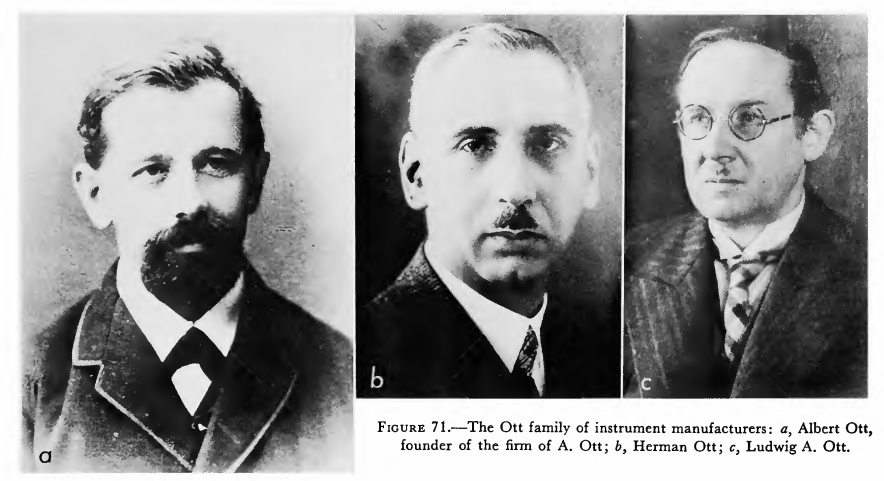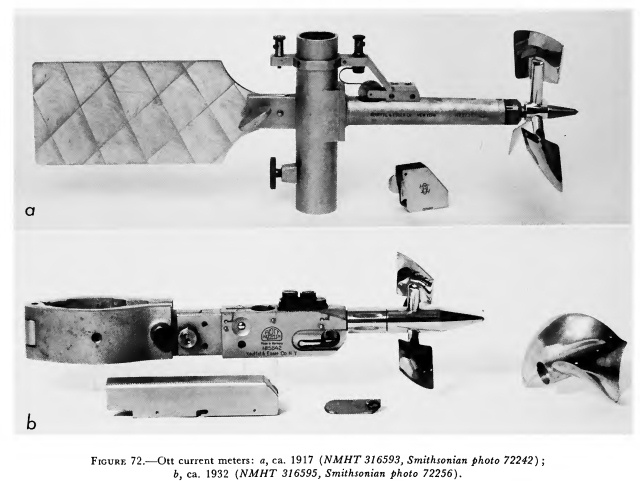|
CECIL E. HANSON COLLECTION |
|
|
Current Meter |
|
|
A. Ott, Germany - Imported by Keuffel & Esser, New York, NY 1909 |
|
.jpg) |
.jpg)
|
.jpg) |
.jpg) |
.jpg) |
|
|
|
.jpg) |
|
Serial Number: 1280 From the Instruction Manuel shown in picture above: "The Vane No. 1280 by A. Ott in Kempten (Type II of the Catalog No.) was calibrated by the company on July 29, 1909..." This indicates that the instrument was manufactured in 1909 by the firm of A. Ott in Kempten, Bravaria, Germany and imported to the United States by Keuffel & Esser. As described in the Instruction Manuel, this current meter uses a mechanical counter to measure stream flow: "The process of a measurement takes place as follows: You first read off the position of the counter, which may be a1, and then bring the vane to the desired measuring point, making sure that its axis is exactly perpendicular to the plane of the transverse profile. Now, by pulling the cord, the counter is engaged and at the same time a stopwatch is started, or, if there is none, the time is read off the second hand of a pocket watch. After a certain number of seconds, e.g. about 60 or 100, the cord is released again, thereby disengaging the counter and lifting the vane out of the water. If the reading a2 is now obtained, then during the observation time, which may be t seconds, the vane has the count: u = a2 – a1. u revolutions are made, so that the number of revolutions per second (n) to be used in the vane equation results from: n = u/t = (a2 – a1)/t" Other versions of current meters could be monitored my an electric signal detected with head phones. The Smithsonian has a A. Ott meter (serial number - 2237, ca 1917) that appears to be of this type (see https://www.si.edu/es/object/nmah_1434200)
Below is the history of the A. Ott firm from
"Water Current Meters in the Smithsonian
Collections of the National Museum of History and Technology" By Arthur
H. Frazier
(Washington, D.C., 1974), pp. 68-71. The Firm of A. Ott
In 1790, Reinhard Woltman publicly
introduced his horizontal-axis water current meter. Its basic design
soon became traditional and many of the improved models which came after
it were called "Woltman" meters, out of respect for the original
inventor. A firm that perhaps has done the most to preserve this
tradition is that of A. Ott of Kempten, Bavaria—today in West Germany.
Albert Ott (1847-1895), its founder (Figure 71a), was the son of a
farmer and postmaster in Nesselwang, South Bavaria. After serving an
exacting apprenticeship in the shop of his uncle, Clemens Riefler, who
manufactured drawing instruments in Nesselwang, he attended the
Polytechnic School in Munich. For short periods thereafter, he worked at
instrument shops in Munich, Vienna, Berlin, London, and Milan before
returning to Bavaria. Upon being left the sole owner of the shop in Kempten, Ott sought ways of increasing his line of scientific instruments. In 1881, therefore, when a leading hydraulic engineer, Professor Andreas Rudolph Harlacher, head of the Hydrographic Services in Bohemia, proposed to Ott that he manufacture Woltman current meters supplied with electric registering facilities on which Harlacher possessed a patent, Ott complied eagerly. Ever since then, the Ott firm has supplied Germany and many other countries throughout the world with current meters, practically all of which have been of a horizontal-axis type such as Woltman had originally conceived. This was a family-owned firm, and when Albert died, it was inherited by his two sons, Herman (Figure 71b) and Ludwig (Figure 71c) with Ludwig (when coming of age) taking the most active part in its operations. In the course of time, Ludwig received a Doctor of Engineering degree from the Technical University in Munich, and was honored for the excellence of his hydrometric, cartographic, and mathematic instruments. Among the several instruments manufactured by the Ott firm that have been contributed to the Smithsonian Institution are the two fairly recent current meters shown in Figure 72. After Ludwig Ott's death in 1946, his elder brother Herman, carried on the administrative and developmental work.
|
|
.jpg)
.jpg)

